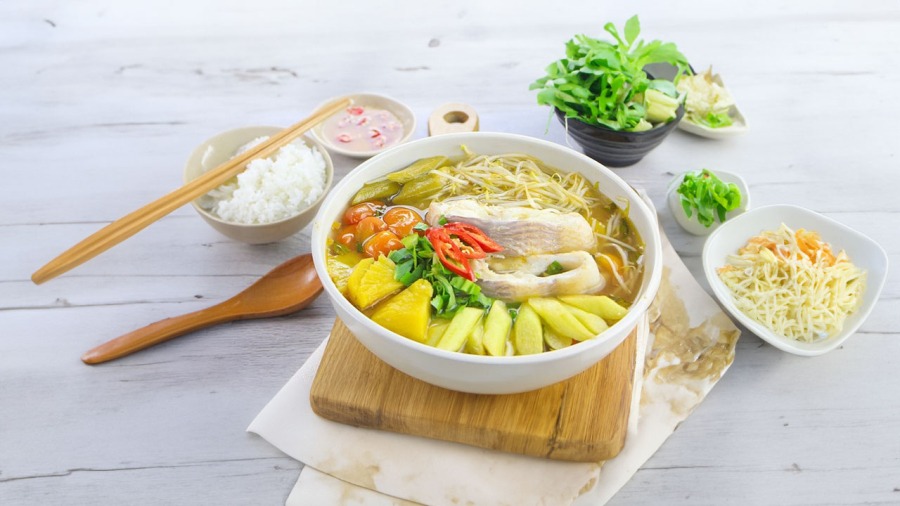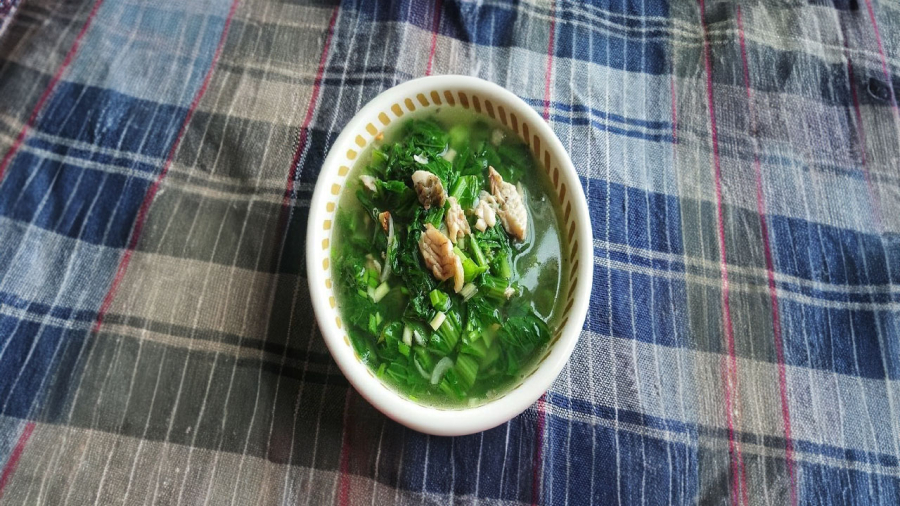Fish soup can be prepared as sour soup (using ingredients like tamarind, pineapple, tomato, cucumber… to create a sour taste) or vegetable soup (which uses fish and vegetables without adding sour ingredients).
Many provinces in the North prepare fish sour soup with ingredients like tamarind, tomatoes, pickles, and aromatic herbs such as dill and spring onions. Some places also add turmeric to enhance the color and eliminate the fishy smell. In the Central and Southern regions, fish sour soup is often cooked with pineapple (to create a fragrant flavor), gourd leaf (rau mồng tơi, Vietnamese coriander), and aromatic herbs such as water spinach and spring onions.
Meanwhile, fish soup without a sour taste is often made with fish cooked with bitter vegetables like bitter melon, bitter lettuce, and green cabbage…

But regardless of the style of fish soup, many people are concerned about how to serve fish soup without it being fishy, with the fish retaining its sweet taste and without any fishy residue. Remember the following steps to ensure that fish soup is never fishy:
Proper fish preparation is crucial
Fresh fish should be cooked immediately to prevent fishiness. This is because fish is rich in protein, and when it is not fresh, this protein breaks down into substances that cause fishiness and can potentially harm the body.
Farm-raised fish tend to be fishier than wild-caught fish. When buying fish, it is important to clean and remove the black membrane, which contains a lot of dirt. The fish should be thoroughly scaled as nowadays most fish are farm-raised, so their fins and tails store a lot of dirt.
To clean the fish, it is best to wash it with saltwater or ginger wine to reduce fishiness and wash away any blood or black membrane inside the fish.

Always use boiling water – an important tip to prevent fishiness and keep the meat tender and sweet
When fresh fish comes into contact with boiling water, the fish meat tightens, and the fish skin cooks quickly, so it does not release a lot of amino acids, which would cause fishiness. Many people still encounter fishiness when cooking fresh fish because they mistakenly use cold water to cook the fish. When fish is immersed in cold water, it releases more amino acids, resulting in a stronger fishy smell, especially when cold water is added during the cooking process.
Cooking fish in boiling water also helps keep the fish meat sweet. Due to the quick tightening of the fish meat when it comes into contact with boiling water, the protein inside the fish meat does not break down, resulting in less fishiness and a sweeter taste. When adding more water, remember to add boiling water.
Adjust the heat properly – the fish will be more tender and less fishy
After the water boils, add the fish and let the soup pot return to boiling, then reduce the heat so that the soup gently simmers. The gentle simmering helps the fish cook evenly and absorb the seasonings without causing the meat to disintegrate. If you continue to use high heat and the soup pot boils vigorously, the high heat and pressure will break down the protein structure in the fish meat, releasing more amino acids into the soup, resulting in fishy meat and a stronger fishy taste.

Boiling the fish soup with an uncovered pot reduces fishiness
When cooking the soup with an uncovered pot, the amino acids that break down in the water evaporate with the steam, which helps keep the soup clear and without fishy taste. If you cover the pot tightly, the fish soup will become cloudy, and when you open the pot, it will have a stronger fishy taste.
Remember the seasonings
A delicious fish soup cannot be made without the right seasonings. The appropriate seasonings depend on the region and cooking style. For example, fish soup in the Northern region cannot be without dill. If cooking fish soup with vegetables, ginger and spring onions are essential. If cooking sour soup, sour and spicy flavors are necessary. In the Southern region, fish soup often includes water spinach… The various seasonings also act as ingredients to reduce fishiness and enhance the aroma in the soup.
Should fish be pan-fried before cooking?
Many people wonder if pan-frying fish before cooking helps reduce fishiness in fish soup. Some families and individuals believe that pan-frying the fish will increase the richness and reduce the freshness of the fish soup. In fact, pan-searing the fish slightly is a way to combat fishiness. When the fish touches hot oil, the fish skin tightens, preventing the release of many amino acids, thus reducing fishiness. This mechanism is similar to using boiling water to make the fish meat tighten quickly without causing fishiness.
However, many people do not like to pre-cook the fish because the high heat and the smell of frying can make the fish soup have a different aroma compared to the aroma of uncooked fish. Cooking pre-fried fish in the soup will create a fragrant taste, but it will also have the smell of oil, making it feel heavier. On the other hand, uncooked fish has a lighter and fresher taste.
Therefore, whether to pan-fry the fish or not depends on the taste preferences and habits of each family. However, when it comes to preventing fishiness, you do not need to pan-fry the fish. You can rely on the steps mentioned above, especially the principle of using boiling water.
Recipe for Fish Soup with No Fishy Aftertaste
Maximizing Durability and Energy Efficiency with High-Speed Kettles: Tips and Advice
Are you an electric kettle aficionado? If so, you’ll appreciate Ði?n máy Xanh’s latest offering. We’ve compiled comprehensive instructions to help you make the most of your electric kettle, including tips on how to prolong its life as well as maximize energy savings. Let’s get your kettle expertise up to date!
“Get Back on Track After Tet: Rejuvenate with These 16 Cleanse-Friendly Foods and Drinks”
As the Lunar New Year festivities come to an end, it’s time to get back on track with healthier eating habits! Check out the cooking section of Ði?n máy XANH for some simple and easy recipes to help revitalize your body and get your energy levels back up. Get ready to start making some delicious and nourishing meals today!



































